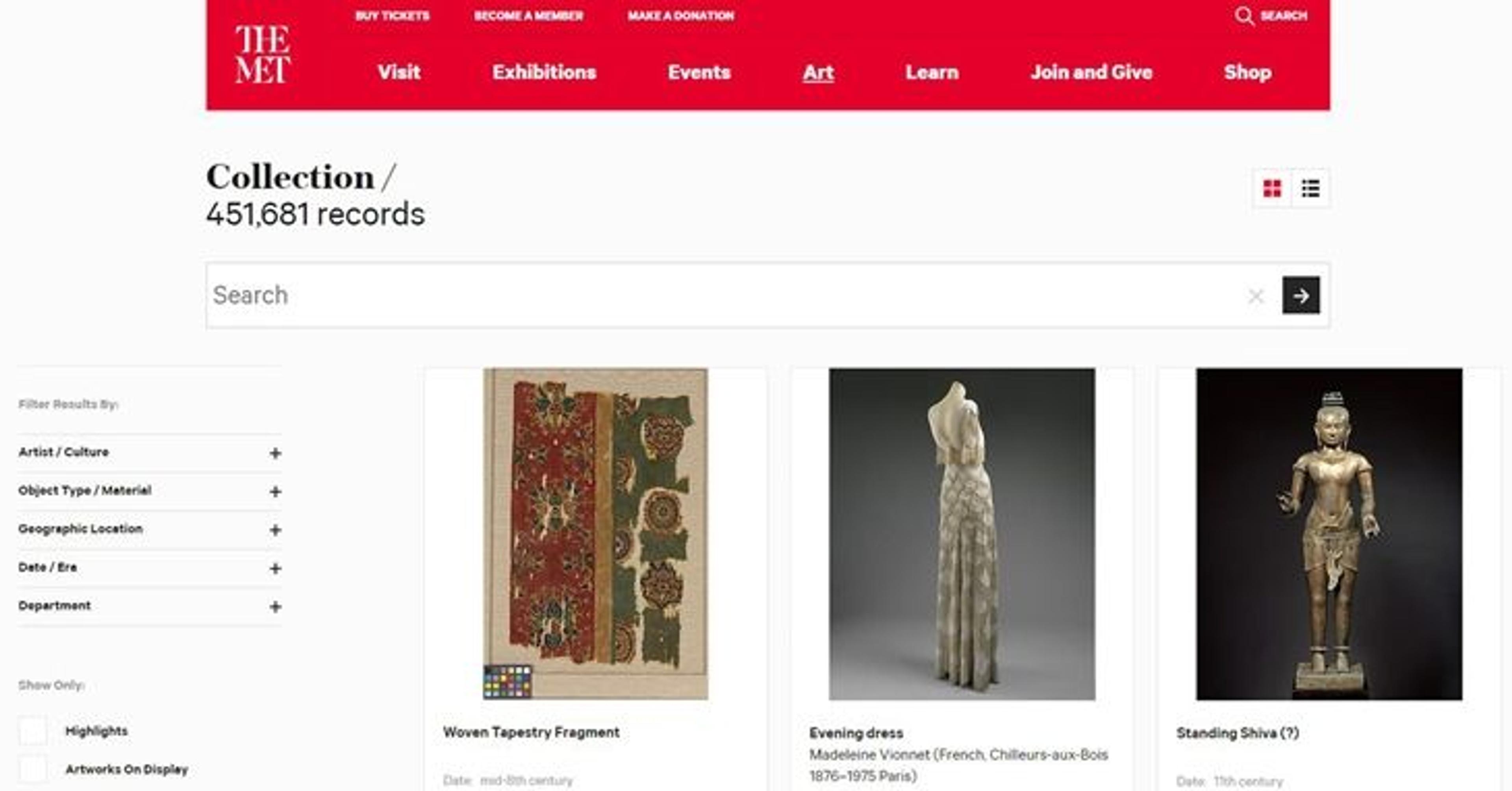
«The Met's online collection currently contains more than 450,000 digitized records—and is growing in number with each passing week. Here, visitors to our website can find information about the Museum's artworks, download high-resolution images, share artwork pages on social media, listen to Audio Guide stops, and explore related content. While it's easy to say how many people visit the online collection—approximately 600,000 per month—the more challenging (and interesting) questions we at The Met hope to answer include: Who exactly are these users? What motivates them to come to our website? What are their needs and expectations when they browse the collection? Where are they coming from?»
I have been trying to answer these questions through user research I've conducted throughout 2017. The aim of this work was to get a better understanding of our users and to define a roadmap to improve the user experience on this important area of the website. To accomplish this, I employed a variety of user-research methods—including Google Analytics, heat maps, and an online survey that received more than 1,200 responses.
User Behavior in the Online Collection
Among the information that analytics reports provide is data about the number of people that come to our website, how long they spend viewing a page, and what the traffic source is that brings them to the website. Analytics also offer insights into each user's behavior, an important data set that influences and informs how we at The Met think about improving the user experience. For instance, 70 percent of the users who come to the online collection land directly on an artwork page via a Google search or by clicking on a link from another website or social media channel. Therefore, while a lot of focus is normally put into our homepage as an entry point to the website, we also need to think about the user journeys when an artwork page is, in fact, the first page of the someone's visit.
Another aspect of the online collection we monitor is the advanced search functionality, which is used by 15 percent of the visitors to our online collection. Analyzing what terms have been searched provides us with great insight into the efficiency and accuracy of our search tools, and gives us ideas of how to best structure the online collection and the related content and scholarship we provide.
Types of Users and Their Motivations
The behavioral data I analyze is a result of each user's individual profile as well as their motivation to visit and explore the online collection. In previous surveys, I asked users about their motivation to visit the online collection in order to learn more about their needs and expectations. Motivational segmentation has also been applied to website visits by other museums—including the Indianapolis Museum of Art, the Tate, and the Museum of Modern Art—and this research shows similar findings when it comes to the driving motives and interest of museum website users. The following chart shows the motivations selected by our users, which include: conducting research, learning, looking for inspiration, and planning a visit to one of The Met's three locations.
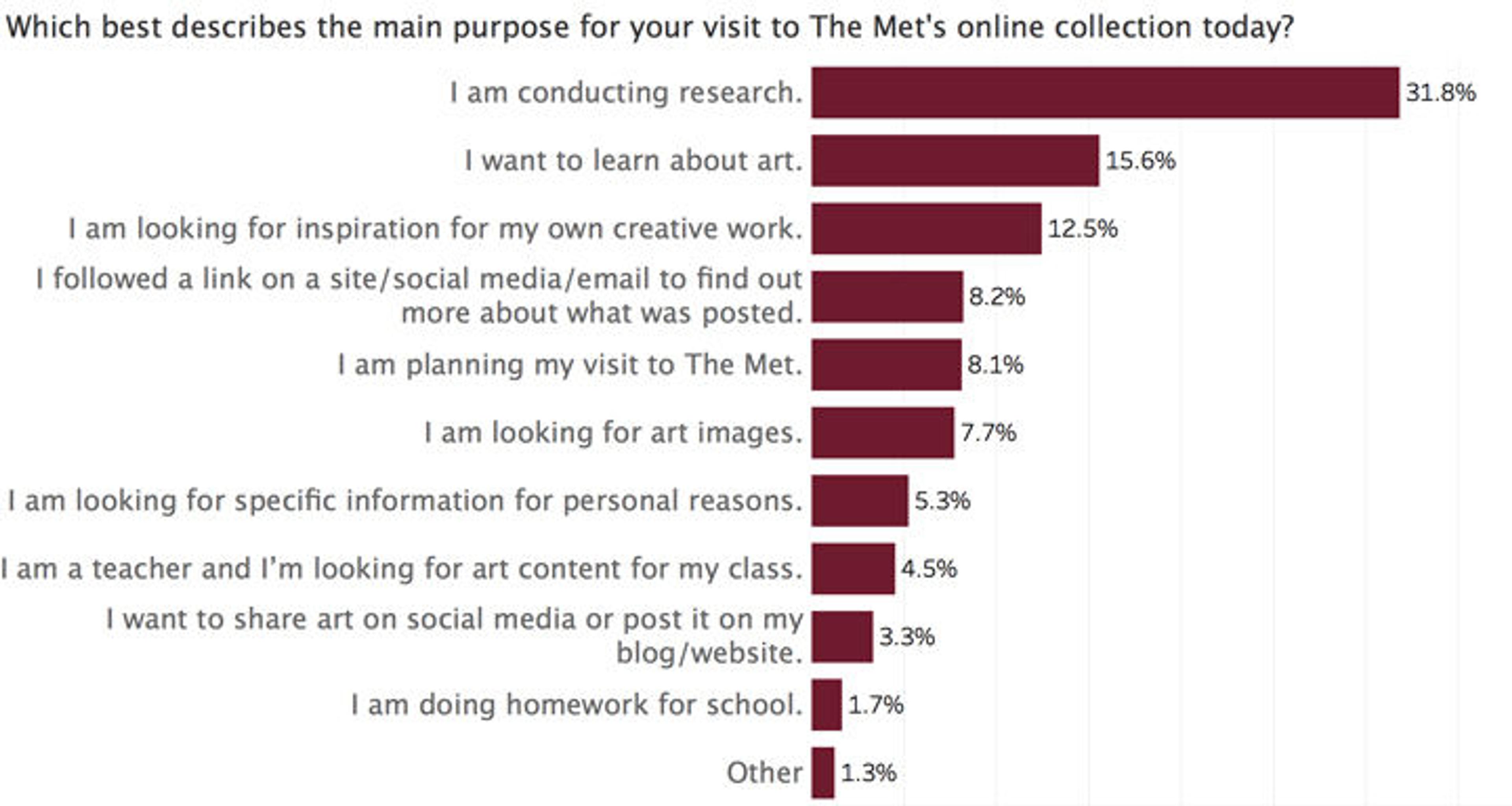
Motivation is just one variable in the whole equation, however, since user experience is also influenced by other factors. For example, looking at the same chart but adding our users' knowledge of art shows us the diversity and range of users within the same motivation category.
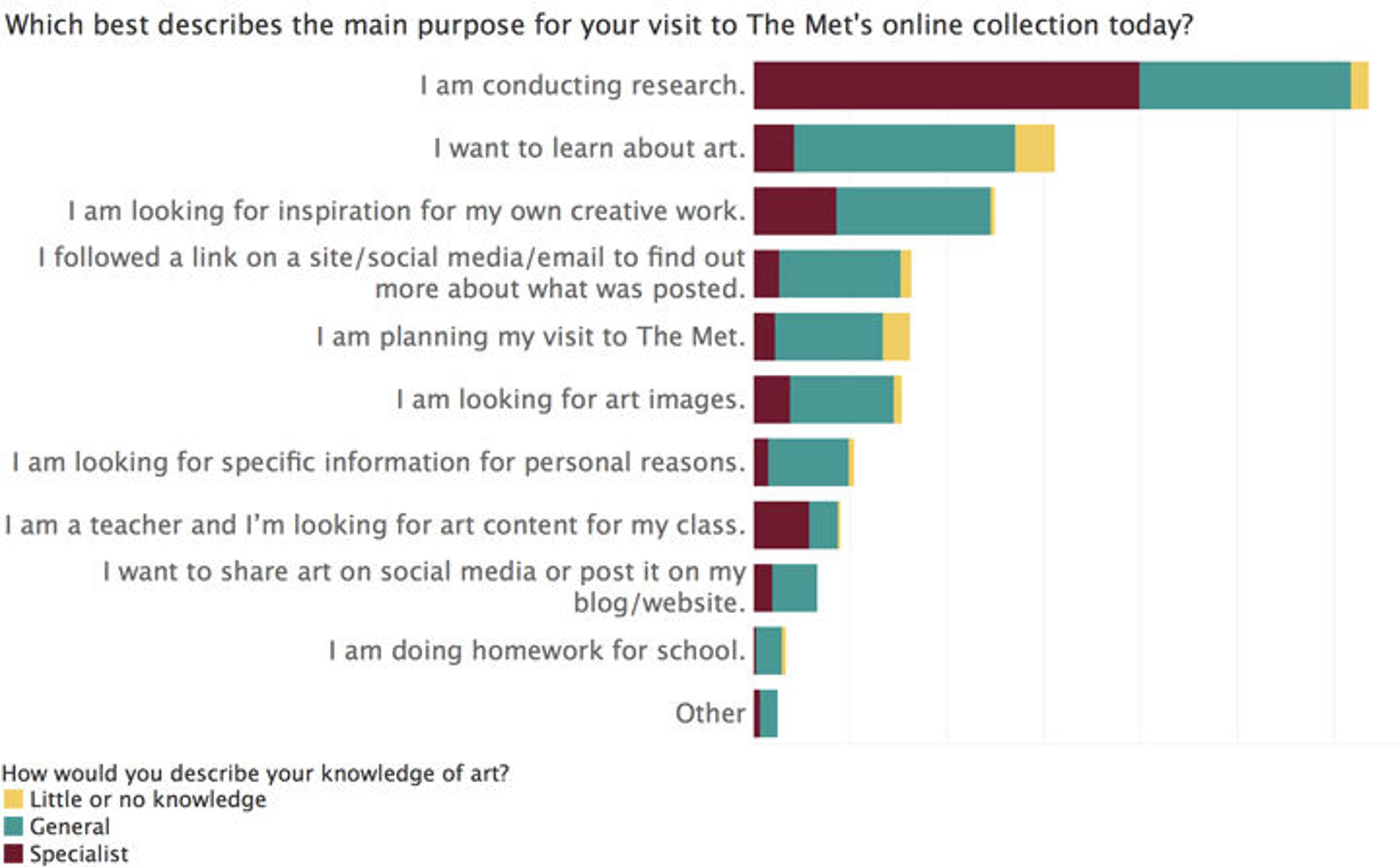
User Segmentation
By analyzing each user's motivation and profile in the context of their use of the online collection, I'm able to define six core user segments: professional researchers, student researchers, personal-interest information seekers, inspiration seekers, casual browsers, and visit planners.
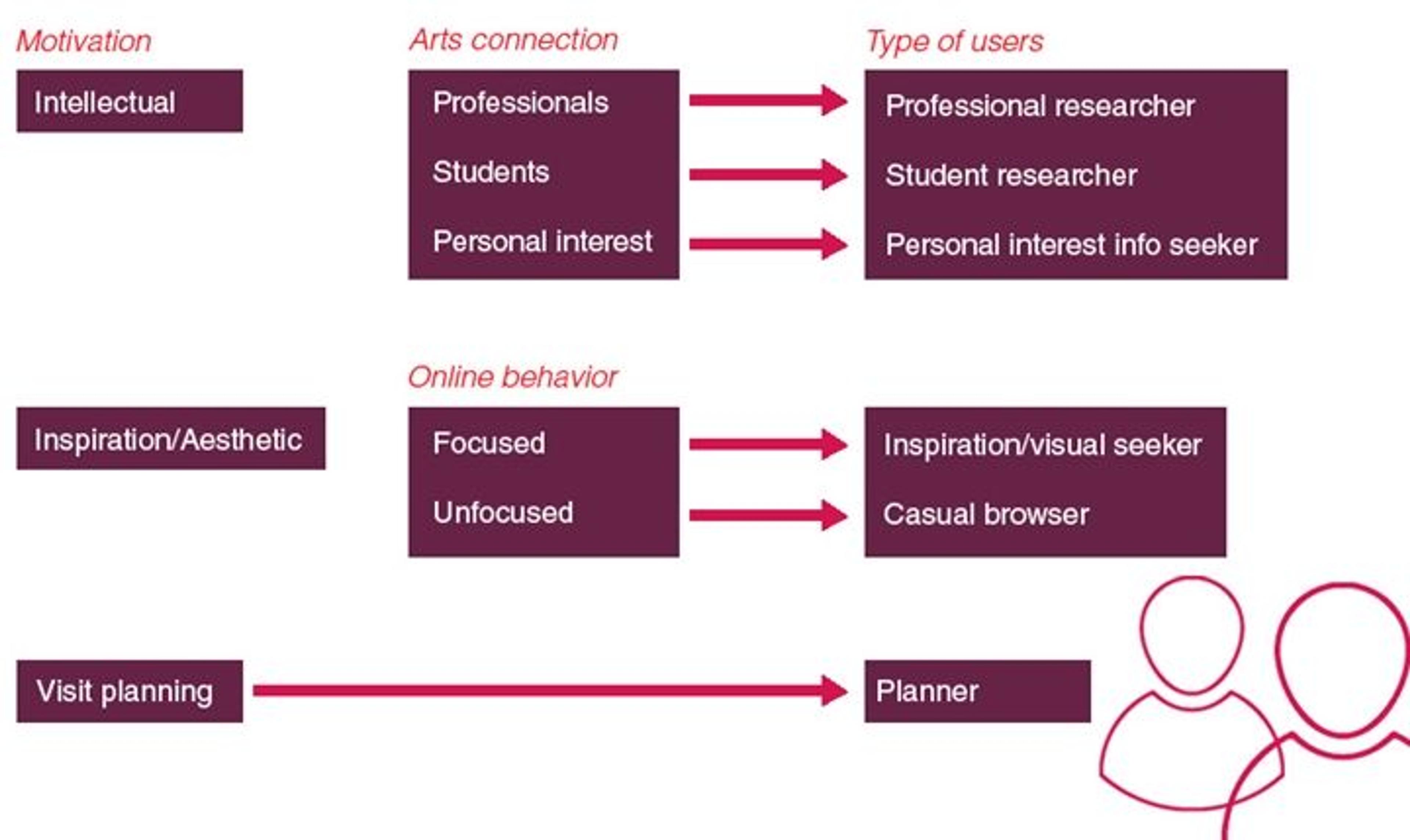
Researchers
While research is frequently mentioned by our users, it actually means different things for different people. I've found that website users may be doing research for a translation, verifying some piece of data about an artwork, researching for a fictional story they are writing, researching fashion designs, or trying to find out the value of a similar artwork they own. Research can be very specific and detailed when the knowledge of the subject is high, but it could also be more open-ended and undefined when the expertise level is lower.
As an example, one user may be searching for objects found in the tomb of Sennedjem while another is performing a general query about modern art. Therefore, each user's background, connection with the museum sector, and knowledge of art influences the information for which they are looking and the various functionalities they are using to find that content. The following chart shows the volume of each user profile based on the survey responses.
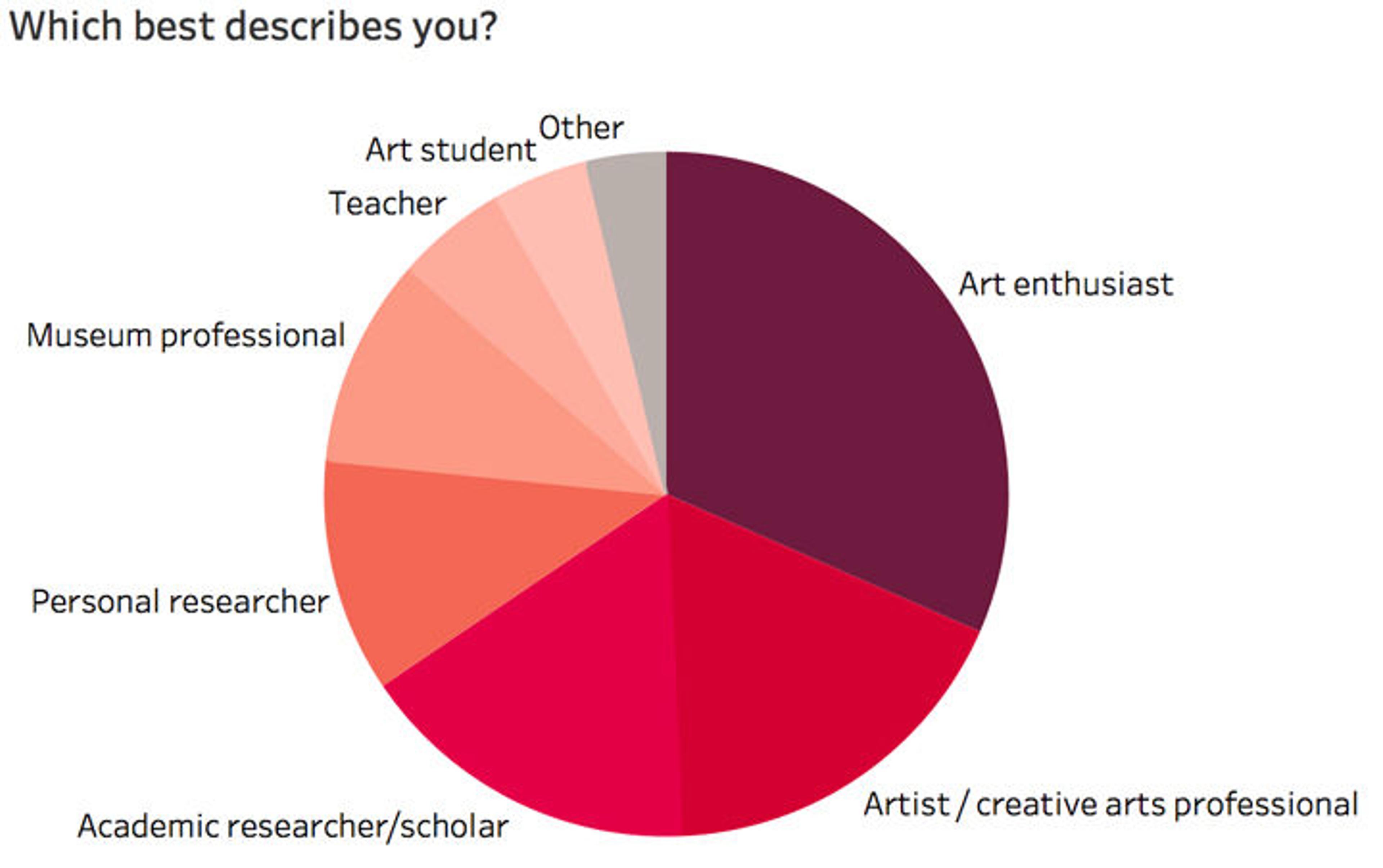
Examining overall motivations but adding the individual user profiles as another set of variables helps to create a classification of visitors in the researcher category:
- Professional Researchers: These users come to conduct research or to deepen their knowledge of art. This segment includes academic researchers, museum professionals, teachers, and artists with high knowledge of art and expertise in the sector. They are frequent users of the website, and 80 percent of these visits happen from a desktop computer. They come from search engines or by directly accessing metmuseum.org. Because of their education and expertise, they are interested in specialist content, the use of advanced search functionalities, and the zoom options available to see details of artworks.
- Personal-Interest Information Seekers: These users are art enthusiasts doing research or seeking a learning experience. Entering the website mainly from search engines, they search for artist names, art movements, or themes, but are not looking for specific information. Because the nature of their searches and their general knowledge of art, they value having contextual text, images, and interpretative material about the artworks in the collection. A quarter of these visits take place onsite at the Museum, or as a follow-up to the art they saw during the visit.
- Student Researchers: As the name indicates, these are users coming to the online collection to conduct research for their studies. In this case, search engines are the main traffic sources, but they also value The Met's website as a resource and are coming directly to the site. They read text and enlarge images to examine an artwork's details, and they are interested in downloading images in high resolution as well as exploring related content about the artworks they are studying.
Inspiration Seekers
A significant portion of visits to the online collection are motivated by a desire to get inspired by The Met collection. These users are normally in a discovery mode, and are looking for something that sparks an idea, stimulates their creativity, or provides a rich visual experience. Within this particular group we can distinguish two types of online behaviors that depend on the intention of the website visit: some may have come to the Museum's website with a specific purpose, while other users came mainly because they stumbled upon a link to the collection on another site and they are seeking a relaxed browsing experience without a definite plan of what to find.
- Inspiration Seekers: Visits by this user segment are driven by a search for inspiration or art images, and includes artists and creative art professionals, art enthusiasts, and personal researchers. These users are focusing their visit on searching for something in particular that can stimulate their creativity. They search for specific artworks and also use filters for browsing the collection. There is a significant amount of visits led purely by visuals in this group, so these users are interested in downloading images and enlarging them to see the works in greater detail.
- Casual Browsers: Similar to the previous group, these users come to the website looking for an inspirational and, in many cases, visual experience. The difference between these users and the inspiration seekers is that casual browsers are not coming to our website with a specific purpose, so their visit is unfocused and freer. They likely clicked on a link to the online collection on another website or came upon The Met's content on social media. More than half of these visits take place on a mobile device or tablet, and Pinterest is a significant traffic driver for this type of user.
Visit Planners
As the name indicates, these are users who are planning their visit to The Met, so they are interested in finding out what they can see during their time at the Museum. This segment frequently uses the highlights filter when searching the collection, and predominantly uses mobile devices for this type of website visit.
How The Met Puts This Information to Use
Defining this user typology helps the Digital Department to plan new content and prioritize the production of new features for the online collection. Additionally, it provides a solid framework to define experiences based on internal requirements and feedback from our website visitors.
To put this into practice, Digital recently held a workshop with members of the Museum's curatorial and conservation departments to turn our ideas and internal requirements into descriptive user stories. This exercise used agile methodologies, in which we focused on the various goals our different users want to achieve with the online collection. Based on the feedback and priorities determined in the workshop, we are now working on a vision for the next iteration of the online collection and determining the ways in which we can measure the impact of this work, since we may need different evaluation metrics depending on the type of user and the unique experiences they seek.
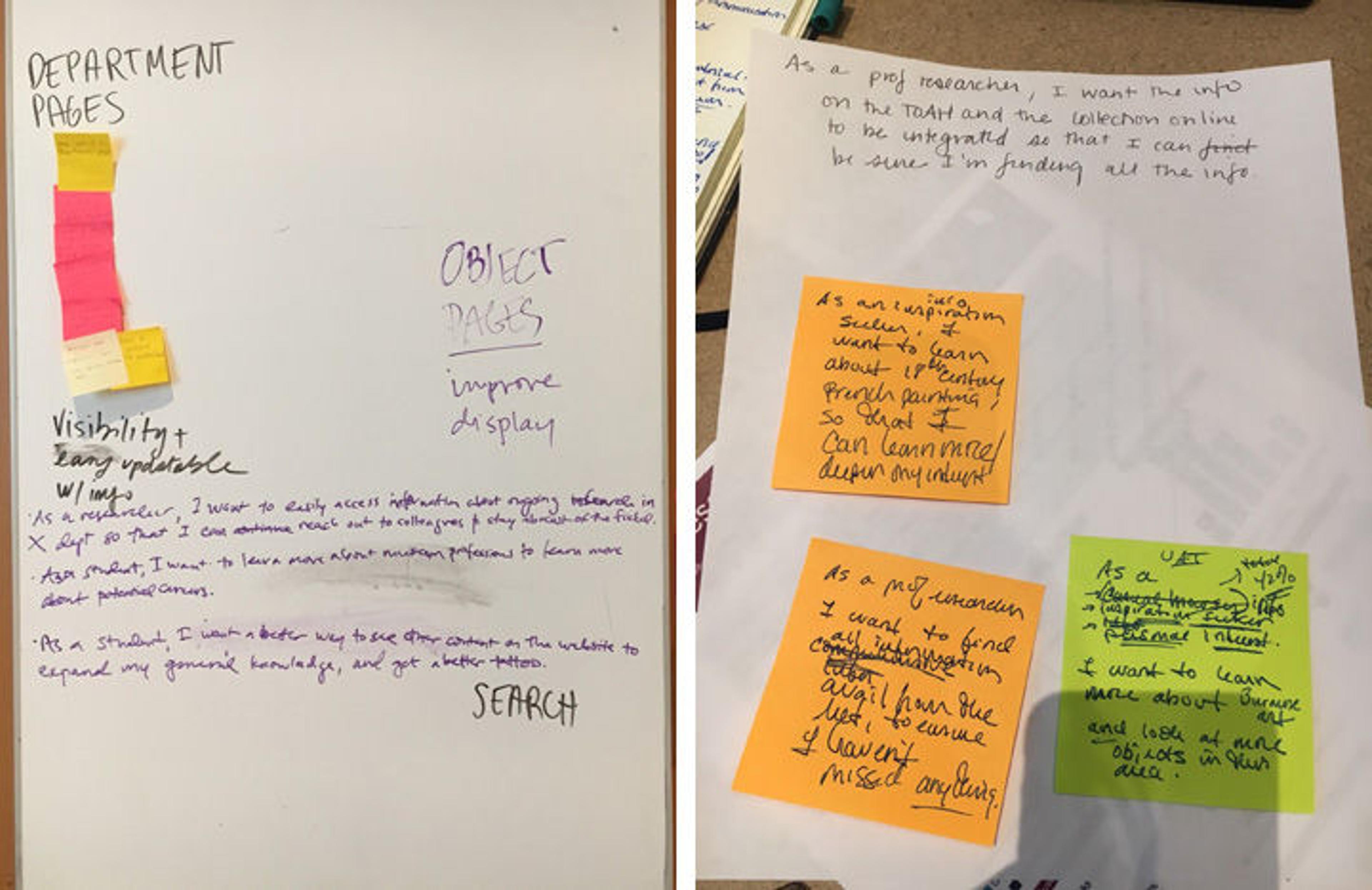
A selection of the user stories defined at the recent online collection workshop. Photos by Liz Filardi
At a more practical level, this segmentation also helps to inform the product plan for the coming months: rolling out a new landing page for the collection, adding content for non-English-speaking audiences, providing more discovery opportunities for inspiration seekers, and designing a new layout for the artwork pages. Be sure to return to Collection Insights for updates about the online collection and the work our team is doing to improve this website experience!
